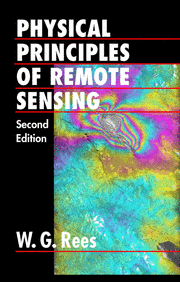Book contents
- Frontmatter
- Contents
- Preface
- Acknowledgements
- 1 Introduction
- 2 Electromagnetic waves in free space
- 3 Interaction of electromagnetic radiation with matter
- 4 Interaction of electromagnetic radiation with the Earth's atmosphere
- 5 Photographic systems
- 6 Electro-optical systems
- 7 Passive microwave systems
- 8 Ranging systems
- 9 Scattering systems
- 10 Platforms for remote sensing
- 11 Data processing
- Appendix 1 The Global Positioning System
- Appendix 2 Data tables
- References
- Hints and solutions to numerical problems
- Index
- Plates section
9 - Scattering systems
- Frontmatter
- Contents
- Preface
- Acknowledgements
- 1 Introduction
- 2 Electromagnetic waves in free space
- 3 Interaction of electromagnetic radiation with matter
- 4 Interaction of electromagnetic radiation with the Earth's atmosphere
- 5 Photographic systems
- 6 Electro-optical systems
- 7 Passive microwave systems
- 8 Ranging systems
- 9 Scattering systems
- 10 Platforms for remote sensing
- 11 Data processing
- Appendix 1 The Global Positioning System
- Appendix 2 Data tables
- References
- Hints and solutions to numerical problems
- Index
- Plates section
Summary
Introduction
In this chapter, we complete our survey of the principal types of remote sensing instrument by discussing those active systems that make direct use of the backscattered power. Optical (lidar) systems are used for sounding clouds, aerosols and other atmospheric constituents, for characterising surface albedo, and for measuring wind speeds. These are discussed briefly in section 9.2. However, the bulk of this chapter is concerned with microwave (radar) systems.
In section 9.3 the ground-work established in chapter 3 is extended to a derivation of the radar equation, which shows how the power detected by a radar system is related to the usual measure of backscattering ability, the differential backscattering cross-section σ0. The remainder of the chapter discusses the main types of system that employ this relationship. The first and simplest is the microwave scatterometer (section 9.4), which measures σ0, usually only for a single region of the surface but often for a range of incidence angles. As described here, this is not an imaging system, although the distinction between microwave scatterometers and imaging radars is not a precise one.
The last two sections discuss the true imaging radars. Section 9.5 describes the side-looking airborne radar (SLAR), or real-aperture radar, which achieves a usefully high spatial resolution in one dimension by time-resolution of a very short pulse. Resolution in the perpendicular direction is achieved by using an antenna with a narrow beamwidth, namely a large antenna.
Information
- Type
- Chapter
- Information
- Physical Principles of Remote Sensing , pp. 213 - 245Publisher: Cambridge University PressPrint publication year: 2001
Accessibility standard: Unknown
Why this information is here
This section outlines the accessibility features of this content - including support for screen readers, full keyboard navigation and high-contrast display options. This may not be relevant for you.Accessibility Information
- 1
- Cited by
